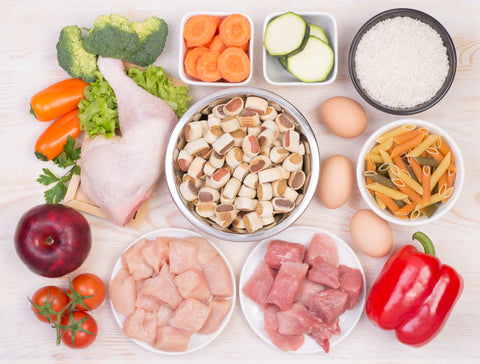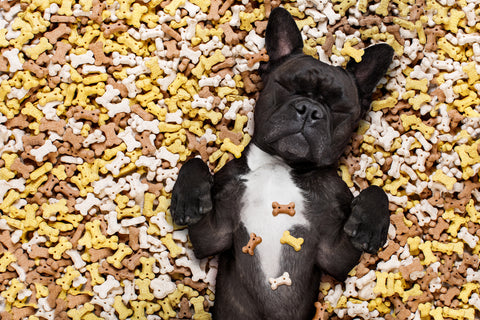
4 Ways to Help Your Dog Lose Weight
You eat well. You exercise enough. You allow yourself snacks and even behave the next day if you have a little extra. You understand the unfairness of how fast weight gain happens versus how long it takes to lose it...
And yes, you’re right: it’s not always an easy road!
So, what’s that road like for dogs?
When I took my dog in for an allergy checkup and found out she’d gained a few pounds, I was overwhelmed at the thought of changing or restricting her diet.
It’s just math and balance work, right? But if it were that simple there wouldn’t be so many overweight dogs in the country. In March, the Association for Pet Obesity Prevention's 2018 survey results reported that 55.8% of dogs in the U.S. are classified as overweight (36.9%) or obese (18.9%).
Ultimately, every dog’s needs are different. Some breeds are more active than others, some dogs only have to shed a couple pounds, and others have a longer journey ahead. Your dog might be older or have health issues.
No matter the background, by building your dog’s weight loss goals off these four guidelines, they’ll have a leg up on those pesky pounds.

1. Basic Diet Changes
Before making ANY changes to your dog’s diet, talk to your veterinarian! I am by no means a doctor or nutritionist, but I am a girl whose dog just began her journey with our vet’s blessing. With that said, the first tip has the most meat to it:
Reduce Calories: Although favored by 68% of respondents to the above-linked survey, it’s not always a black and white scenario. Kibble bag guidelines are typically set for adult dogs who are active and intact. If your dog is older, not as active, and has been spayed or neutered, you could be feeding them 20-30% more than they need! This is a formula to calculate the base caloric intake for dogs like yours:
- Divide your dog’s weight by 2.2
- Multiply this number by 30
- Add 70
My dog’s result is 945 calories per day, which seems shockingly low by human standards! So, I brought it to our vet. Because my dog is young, active, and spayed, our doctor recommends keeping her intake between 989-1000 calories a day — treats included — until she’s back to her target weight. Whichever feeding method you choose for your dog, a measuring cup or food scale will go far in keeping their portions in check. Trust me, it’s easy to overfeed by accident: an overtopped cup here and there adds up!
Increase Protein, Lower the Carbs: Lots of commercial dog foods on the shelves have fillers that are stuffed with calories. And while there are several nutritious, grain-free brands to choose from, some of them rely on starchy, carby foods like lentils and potatoes — which won’t help your dog with weight loss. This would be the perfect time to chat with your vet about which high protein, low carb dog food is best for your pal’s needs... and you can even ask about making your own fresh dog food! Prepackaged meals are super convenient, but you’ll save TONS of money on the same health benefits by setting up a crockpot for the day. Talk to your vet about recipe ingredients to make sure that all their nutritional needs are met.
My dog starts a fresh, homemade diet in just a couple of days, which will make it easier for me to control her portions. I’m transitioning her from a raw feed diet.
Raw Feeding: My reasons for switching my dog off raw feeding are mostly financial, and less to do with the ongoing debate about raw fed dogs. We got baseline bloodwork done when she started her raw diet, and at her last checkup her chemistries were still normal. If you’ve got the finances, storage space, and perseverance to ensure your dog is getting all their vital nutrients, talk to your vet about raw feeding if other options haven’t helped your dog lose weight.
If your dog’s diet is clean and you’re on point with portion control, there’s another food-based culprit to consider...

2. Trim the Treats
Remember when I said treats included? Yep. This is where my dog’s pesky 3.5 lbs. came from over the last month! Self-restraint in the doggie treat department is a tough one. If your dog is brand new or you’re working on positive training methods, my guess is you’re going through TONS of treats!
As hard (or as cruel!) as it feels to restrict treats your dog is working their hardest for, there’s a happy medium here:
Stick to high-protein treats like air dried venison or dehydrated veggies and break them up into pea-sized bits. This way, you can keep rewarding positive behavior while keeping your dog’s caloric intake within range.
Now would be the time to check in with your dog on their training goals to sort out which behaviors and cues will benefit from phasing out treats and switching to praise or play!
3. Get Moving...
Speaking of play... adding more exercise to your dog’s daily routine not only helps them shed those pounds, but it also provides mental stimulation — which makes for a happier dog!
Your goal is to shoot for 15 minutes of strenuous activity, 2 times a day... but it’s important to start slowly — especially if your dog is obese or elderly. Here’s a few “slow start” tips you can incorporate on daily walks:
- Add 5 minutes to each walk
- Add an extra block to each walk
- A brisk pace: speed up for 1 to 2-minute increments at a time
Anything is better than nothing: if your dog’s never really been walked before, starting with a 5 to 10-minute sniff-laden stroll is perfectly acceptable! If you have a pool or access to dog-friendly waterfronts, swimming is a wonderful option for low-impact exercise.
If you have limited mobility, there’s other fun ways to exercise your dog indoors. Hide and seek, scavenger hunts (with healthy treats of course!), and obstacle courses are BIG in our house on days my herniated disc and I aren’t getting along. These games are great for rainy days and wintertime, too!
Always be mindful about any health concerns with your dog: excessive tag or stair climbing won’t be good for dogs who are elderly, arthritic, or recovering from an injury.

4. ...But Remember: it’s Not a Race!
How many times have you pulled an outfit from your closet in the springtime... only to find it’s a little snug? (I’m looking away, here...) We lament about long winters and yet that gain feels so very sudden.
Yeah, it feels like it happened out of nowhere... but it didn’t. So, losing the weight won’t happen overnight, either. Along with diet changes, treat trimming, and exercise, time and consistency will be your dog’s best friend on their weight loss journey!
Don’t risk an injury to your dog for the sake of helping them slim down. If your dog is extremely obese, making slow, gradual changes will be paramount for both their health AND their success... but this is a wise way to start no matter your dog’s size, age, or needs.
A Final Tip... and a Ray of Hope!
I can’t stress enough how important it is to move gradually, so I want to remind you that any of these steps can be broken down even further. It’s a given that changes in your dog’s diet should happen slowly, but here are other areas you can break things down:
- 1-2 minutes of hide and seek
- A mini-walk up and down your drive or walkway
- A slow stroll around the living room, encouraging your dog to follow (this can later be turned into hide and seek, tag, quicker laps, or an obstacle course)
It’s also easy to slack off a little when you begin to notice progress. Raise your hand if you’ve ever rewarded a weight loss goal with a day off exercising or extra helpings of dessert! (Yeah, I’m looking away here, too!)
Rewarding your dog with an extra treat might not be a big deal, but it’s easy to slide back into old patterns — and those treats will add up. By approaching your dog’s weight loss as a full lifestyle change, you open doors to lots non-food rewards:
- An afternoon sniffari
- A new toy
- Warm, soothing praise
- Scritches in their favorite places

Listen, I know that goals feel impossible when you’re standing on the starting line with your dog looking to you for guidance. In moments like this I find that an honest, feel-good story makes a great substitute for a starting pistol.
I read this story about Kai a few weeks ago, and suddenly my own dog’s journey felt far more manageable. I realized that no matter how many obstacles are littering the path, there is always a way around them.
If your dog is on a healthy path to losing weight, we’d love to hear about it! (Bonus if you’ve got some progress pictures to share!)
Did you enjoy this post? Please give it a like and share it with your friends! Thanks! 🐶❤️🐾
